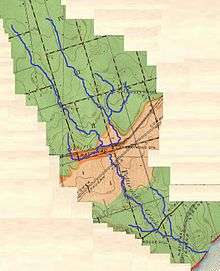Petticoat Creek

Petticoat Creek is a watercourse in Pickering, Ontario and Toronto, Ontario.[1] Its watershed covers 27 square kilometres (10 sq mi), and the cumulative length of all its branches is 49 kilometres (30 mi). Land use in the watershed consists of 52% agricultural, 27% protected greenspace and 21% urban. Municipalities within the watershed include Pickering, Markham and Toronto.[2]
According to the Toronto Region Conservation Authority the ″Petticoat Creek watershed is dominated by the South Slope physiographic region, a smooth, faintly drumlinized till plain.″[3] Because the creek is not long enough for its headwaters to lie within the groundwater rich Oak Ridges Moraine, waterflow on the upper reaches is intermittent and dependent on precipitation. Lower reaches, below the ancient shoreline of glacial Lake Iroquois, is more consistent.
See also
References
- ↑ "Petticoat Creek: watershed". Toronto Region Conservation Authority. 2012. Archived from the original on 2012-11-23. Retrieved 2012-11-23.
Today, Petticoat Creek watershed represents a continuum between natural, rural and urban land uses and is best described as an urbanizing, warm-water system. Natural and rural areas of the watershed, comprising roughly two-thirds of the land base, are protected under selected provincial initiatives, explained below. The long history of agriculture in this area has not resulted in significant degradation of the northern portion of the watershed. The agricultural community has generally been a good steward of this land.
- ↑ "Petticoat Creek". Toronto and Region Conservation for The Living City. 2013. Retrieved 2013-02-15.
- ↑ "Petticoat Creek: Watershed Features". Toronto Region Conservation Authority. 2012. Archived from the original on 2012-11-23. Retrieved 2012-11-23.
Historically, the watershed would have been predominantly covered in forest and wetlands. Over time this natural cover, along with its environmental benefits, was diminished by human activity to what is now considered below the desired level. Today, natural cover in the form of forests, wetlands, and meadows is concentrated in public greenspace areas:
External links
Coordinates: 43°48′18″N 79°06′46″W / 43.804934°N 79.112651°W